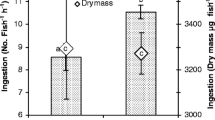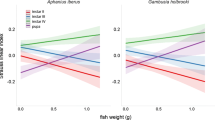Abstract
Under laboratory conditions Aphanius was more successful than Gambusia in preying upon the 3rd, 4th and pupal stages of mosquitoes. The reverse was found for the first two instars. However. Aphanius consumed more 2nd instar larvae under the cover of vegetation when larger fish were able to penetrate shallow water and feed on the mosquito larvae.
The two species showed a similar prey-size selection except for Aphanius of the medium size (31–35 mm) which ate larger larvae than Gambusia of the same size range.
When provided access to the surface, neither fish species showed any adverse effect at oxygen levels as low as 0.5 mg l-1 (6% saturation). When denied access to the surface, both species behaved ‘normally’ at oxygen levels as low as 1.3 mg l-1 (15% saturation).
This study suggests that Gambusia affinis and Aphanius dispar can complement each other as mosquito control agents in different habitat conditions. We suggest that in mosquito infested situation which are characterized by high organic matter and low oxygen levels biological control could best be achieved by introduction of a range of sizes of both fish species. Repeated introductions of the fish, in large enough numbers, may be required for ad-hoc alleviation of a mosquito problem. Best results are thus to be expected in relatively small water bodies such as oxidation ponds.
Similar content being viewed by others
References
Ahmed, Y. A. & A. Isaq, 1982. Field trial on the impact of Oreochromis spilurus spilurus on malaria transmission in northern Somalia. W.H.O. EM/MAL/191 EM/SOM/ MPD/001/RB, 25 pp.
Angerilli, N. P. D., 1980. The influences of extract of freshwater vegetation on the survival and oviposition by Aedes aegypti. Can. Ent. 112: 1249–1252.
Angerilli, N. P. D. & P. Berine, 1980. Influence of aquatic plants on colonisation of artificial ponds by mosquitoes and their insect predators. Can. Ent. 112: 793–796.
Blaustein, L., 1989. Spatial distribution of Anopheles freeborni, Gambusia affinis and Lepomis cyanellus in experimental rice plots. J. am. Mosq. Control Ass. 5: 254–257.
Blaustein, L., 1992. Larvivorous fishes fail to control mosquitoes in experimental rice plots. Hydrobiologia. 232: 219–232.
Byniak, E., 1973. Influence of day length and temperature on the reproduction of Aphanius mento (Cyprinodontiformes, Teleostei). Ph. D. Thesis, Hebrew University, 96 pp (in Hebrew).
Carlson, D. B., R. R. Vigliano & G. L. Wolfe, 1986. Distribution of mosquitoes in different wastewater stages of secondarily treated domestic effluent and untreated citrus wastewater. J. Am. Mosq. Control Ass. 2: 516–521.
Castleberry, D. T. & J. J. Cech, 1990. Mosquito control in wastewater: a controlled and quantitative comparison of pupfish (Cyprinodon nevadensis amargosae), mosquito fish (Gambusia affinis) and guppies (Poecilia reticulata) in Sago pondweed marshes. J. am. Mosq. Control Ass. 6: 223–228.
Chapman, H. C., 1974. Biological control of mosquito larvae. Ann. Rev. Ent. 19: 33–59.
Crowder, L. B., 1990. Community ecology. In Schreck, C. B. & P. B. Moyle (eds). Methods for fish biology. Am Fish. Soc. Bethesda, Maryland, 609–627.
El Safi, S. H., A. A. M. Haridy & F. M. A. Rabaa, 1985. The food of the larvivorous fish Gambusia affinis (Baird and Girard) and Oreochromis (formerly Tilapia) niloticus (Linnaeus) in Gezira irrigation canals. J. trop. med. hygien. 88: 169–174.
Goren, M., 1983. The freshwater fishes of Israel. Biology and Taxonomy. Hakibuz Hamehuchad Publishing House. Tel Aviv, 102 pp (In Hebrew).
Haas, R., 1984. Guide for preliminary identification of some larvivorous fish. W.H.O. VBC/84.1, 44 pp.
Haas, R. & R. Pal, 1984. Mosquito larvivorous fishes. Bull. ent. Soc. Am. 30: 17–25.
Hess, A. D. & C. M. Tarzwell, 1942. The feeding habits of Gambusia affinis affinis with special reference to the malaria mosquito, Anopheles quadrimaculatus. Am. J. Hygien. 35: 142–151.
Hoy. J. R., E. G. Kauffman & A. G. O'Berg, 1972. A large scale field test of Gambusia affinis and Chlorpyrifos for mosquito control. Mosq. News 32: 161–171.
Hurlbert, S. H., J. Zedler & D. Fairbanks, 1972. Ecosystem alteration by mosquitofish (Gambusia affinis) predation. Science 175: 639–641.
Houston, B. N., B. N. Dancer & M. A. Learner, 1989. Control of sewage filter flies using Bacillus thuringiensis var. israelensis I. Acute toxiticy tests and pilot scale trials. II. Full scale trials. Wat. Res. 23: 369–385.
Jones, J. C., 1978. The feeding behavior of mosquitoes. Sci Am. 238: 112–121.
Krumholtz, R., 1948. Reproduction in the western mosquitofish Gambusia affinis and its use in mosquito control. Ecol. Monogr. Durham, North Carolina. 18: 1–43.
Margalit. J., C. Pascar-Gluzman. H. Bobroglio & Z. Barak, 1985. Biocontrol of mosquitoes in Israel. Integrated Mosquito Control Methodologies, 2: 361–374.
Mortenson, E. W., 1982. Mosquito occurrence in wastewater marshes: a potential new community problem. Proc. Pap. Ann. Conf. Calif. Mosquito Vector Control Ass. 50: 65–67.
Mulla, M. S., H. A. Darwazeh & M. S. Dhillon, 1981. Impact and joint action of decamethrin and permethrin and fresh water fishes on mosquitoes. Bull. environ. cont. tox. 26: 689–695.
Nasir, A. S., 1979a. History of the use of larvivorous fish for larval control in Somalia. W.H.O. EM/TR. SMR. LRV. FSH. MSQ. CTR/Somalia, 3 pp.
Nasir, A. S., 1979b. Important species of fish used for larval control in the Anti Malaria Program in Somalia, with special reference to Tilapia zilli and Nothobranchius palinquisti. W.H.O. EM/ST. SMR. FSH. MSQ. CTR/7.3 Somalia. 9 pp.
Pant, C. P., N. Rishikesh, Y. H. Bang & A. Smith, 1981. Progress in malaria vector control. Bull. W.H.O. 59: 325–333.
Schaefer, C. H. & T. Miura, 1985. Mosquito breeding in a cat tail marsh used for treatment of secondary sewage effluent. In B. Tabraham & J. Coates (eds.) Mosquito Res. Control Board Annual Report. Univ. Calif. Division of Agriculture and Natural resources, Berkley CA.: 80–82.
Walters, L. L. & E. F. Lenger, 1980. Impact of the desert pupfish, Cyprinodon macularius and Gambusia affinis affinis on fauna in pond ecosystems. Hilgardia 48: 1–18.
W.H.O., 1980 (1979). Report of the travelling seminar on the use of larvivorous fish for mosquito control in anti malaria campaigns. Golden Sands Bulgaria/Tbilisi Georgian Republic, SSR, USSR. EM/VBC/22: EM/TR.SMR. LRV.FSH.MSQ.CTR/14, 35 pp.
W.H.O., 1982. Manual on environmental management for mosquito control with special emphasis on malaria vector. World Health Organization, Publ. No. 66, Geneva, 283 pp.
Wurtsbaugh, W. H. & J. J. Cech, Jr., 1983. Growth and activity of juvenile mosquitofish: Temperature and ration effects. Trans. am. Fish. Soc. 112: 653–660.
Wurtsbaugh, W. H., J. J. Cech & J. Compton, 1980. Effect of fish size on prey size selection in Gambusia affinis. Proc. 48th Ann. Conf. Calif. Mosq. vector cont. Ass.: 48–51.
Zaman, M. S., 1980. Malaria control through fish. Pakistan J. Sci. 32: 163–168.
Author information
Authors and Affiliations
Rights and permissions
About this article
Cite this article
Homski, D., Goren, M. & Gasith, A. Comparative evaluation of the larvivorous fish Gambusia affinis and Aphanius dispar as mosquito control agents. Hydrobiologia 284, 137–146 (1994). https://doi.org/10.1007/BF00006885
Received:
Revised:
Accepted:
Issue Date:
DOI: https://doi.org/10.1007/BF00006885




